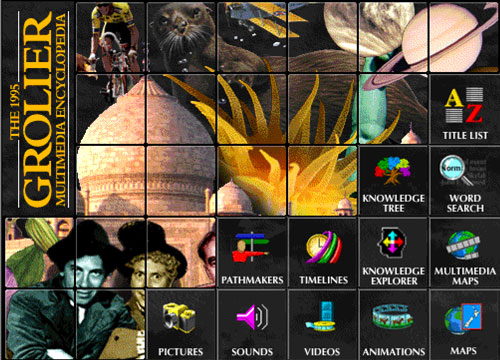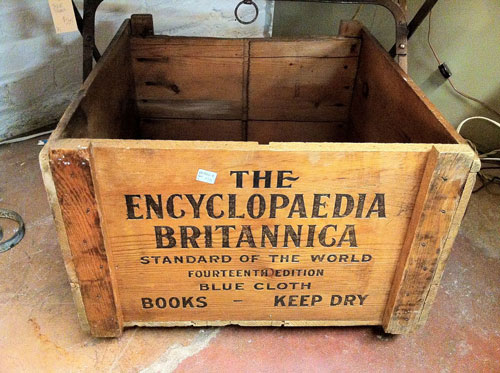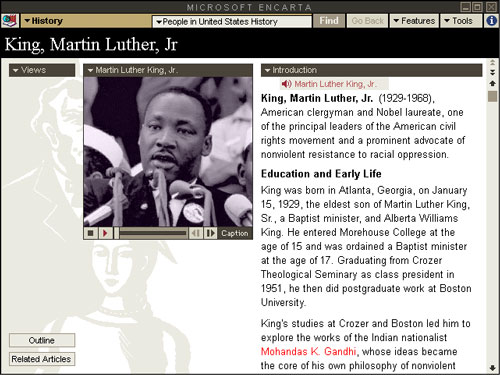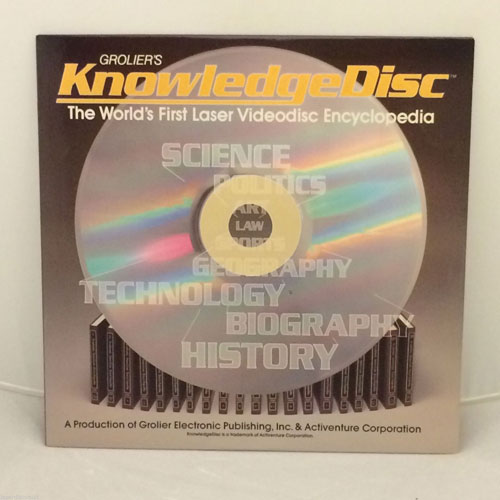How the CD-ROM Killed the Physical Encyclopedia
Credit to Author: Ernie Smith| Date: Mon, 11 Sep 2017 12:00:00 +0000
A version of this post originally appeared on Tedium, a twice-weekly newsletter that hunts for the end of the long tail.
The CD-ROM was sold to the public and the world as a way to bring interactive multimedia experiences into our homes. (Certainly, that’s how the magazine world tried to sell it.)
But beyond that, it was a huge amount of storage for a price that was insane to consider at the time. And that meant that some of the earliest products produced for the CD-ROM format were of the reference variety. Specifically, in encyclopedia form.
We take Wikipedia for granted these days, but the encyclopedia on disc was a big deal—especially because it was both cheaper and smaller than the alternative.
But CD-ROMs had a seriously disruptive effect on an industry made for physical books. According to a 1980 estimate from the Book Industry Study Group published in the Chicago Tribune, physical encyclopedias accounted for $400 million in retail sales, driven by large publishers who would get people to sign up for monthly contracts. The books were sold to the public through retail channels or even salespeople. These books were often costly, but also high-margin, allowing encyclopedia companies to invest in fairly in-depth takes on different kinds of topics.
But an upstart publisher who was looking to make headway in the encyclopedia world decided to dip its toes into the digital world. And in the long run, their early moves set the stage for a disruption that couldn’t be dialed back.
The first major CD-ROM encyclopedia publisher was an upstart that forgot the pictures
Nine million words. 32,000 articles. No photos. No maps.
But then again, it didn’t weigh 50 pounds, either.
The first attempt to bring the encyclopedia to a digital format wasn’t flashy or even sexy, but it did solve a bit of a problem with the original format of the encyclopedia, which was that it was a very bulky information vessel.
The company that came to the idea first was a firm called Arete Publishing, a Dutch company that had its sights on taking over the American market for the first time with its Academic American Encyclopedia. Over a six-year period, the firm put together a brand-new encyclopedia, a $20 million investment, with the hope of taking on the big guys already on the market—namely, Encyclopædia Britannica and World Book. The company initially had set sights for its content in the world of retail, and it wasn’t exactly coming at the market with the world’s best sales pitch.
“The retail strategy is a radical and risky one, especially for a no-name publisher with no domestic experience or brand identity,” Chicago Tribune marketing columnist Elizabeth Brenner wrote in 1980. “Indeed, in approaching retailers this year, it did not even have a finished product.”
Fortunately, Arete had an ace up its sleeve: It was much more flexible about putting its words on different kinds of formats compared to its more established competition, and it quickly partnered with both CompuServe and Dow Jones News Service to bring its encyclopedia to modem-accessible databases as something of an extension of the existing newspaper databases on the services. Some felt the offering was broad, but a little skimpy.
“You can get a dab of almost anything you want in CompuServe, but it isn’t very substantial,” syndicated tech columnist Peter McWilliams wrote. “For instance, the encyclopedia gives me only three or four short paragraph summaries of anything I look up. The movie reviews are longer, but there are less than 30 reviews at a time. Aren’t databases known for their storage power?”
By 1984, the company had started experimenting with bringing its encyclopedia out in optical disc form. We were still in the period before CD-ROMs were even on the market in any meaningful way, so Arete, which was acquired by the encyclopedia publisher Grolier in 1985, put its energy into getting its multi-volume encyclopedia onto a Laserdisc—something called the Grolier KnowledgeDisc.
Even by late 1985 standards, the cost savings compared to a shelf of physical books was fairly impressive, Philadelphia Daily News columnist Jonathan Takiff noted:
Better still, a user isn’t just saving on time, energy and shelf space by going with the electronic version, but also is saving big bucks. The printed, 21-volume version of the Academic American costs $650; the laser disc treatment is $89.95. A Pioneer PR-8210 laser disc player with remote control goes for about $450, so you’re still ahead, even with the hardware investment. With the laser player, you also wind up with a wonderful entertainment programming source. There’s a rich library of music and movie titles available on the high-grade and laser disc medium, at prices lower than videotape equivalents.
And remember, Laserdisc was not a cheap medium in the 1980s. But it still beat out the cost of the physical encyclopedia. Even though the navigation was being done on remote-driven device rather than something where you could copy-paste data and quote from it in a report, it was still better than the alternative in so many ways. Compared to better-known volumes, the price difference was even more stark. And Grolier Electronic Publishing knew the direction that things were going years before any of its competitors did.

“With our CD-ROM encyclopedia, you’ll easily find dozens of references to a topic, instead of just the obvious three or four,” Frank J. Farrell, the president of Grolier Electronic Publishing, explained to Takiff. “If, say, you want to research German subs, you’ll also be pointed to unexpected references like Ernest Hemingway, who spent two years hunting German subs on his private yacht. If you’re interested in Oedipus, you’ll come up with 34 references, including Thomas Hardy, who used the Oedipus theme for his first critically acclaimed novel.”
Grolier didn’t end up winning the battle, but it had an impressive head start.
“We knew from the beginning that we were a temporary business, eventually to be overtaken by the internet.”
— Tom Corddry, the head of Microsoft’s multimedia projects during the 1990s, discussing in an interview with Business Insider how it approached its reference products, particularly Encarta, which was released in 1993, but also Bookshelf, a program first released in 1987 that integrated reference materials from the World Almanac, the Chicago Manual of Style, and Bartlett’s Familiar Quotations, among other reference materials. Basically, these products existed as loss leaders of sorts for Microsoft, ways to ensure that the mainstream public got hooked on computers. But starting off wasn’t cheap or easy: According to InfoWorld, Microsoft agreed to let Bookshelf be bundled with an early CD-ROM in 1987, at a cost of $1,099 for the full package—or, with inflation added, $2,400 today. (Considering the World Almanac was being sold for less than $6 in printed form at the time, it was a tad expensive.)

Did the Encyclopaedia Britannica blow the digital revolution?
As Grolier and Microsoft were basically reinventing the world of reference materials in the late 1980s, the Encyclopaedia Britannica was having a pop culture moment.
https://www.youtube.com/watch?…
The company got famed satirist Stan Freberg to do their ads, and Freberg decided to let his son Donovan, a real smart-alecky kid, do the selling. The move created the most popular encyclopedia ad icon ever and arguably made giant multi-part research book libraries kind of cool for a couple of years.
But in the midst of all this success, the Encyclopaedia Britannica folks got a nudge from Microsoft—hey, we’re working on a multimedia encyclopedia, it’s going to be really awesome and highlight your work in the most impressive possible light; you want in?
Sounds like a good idea, but there was a problem. The Britannica folks had hooked families onto $1,400 investments with Donovan Freberg’s help. (And that’s in 1988 money; it’d be worth $2,900 today, or the price of a 15-inch MacBook Pro with some of the upgrades checked off.)
Also a factor was the fact that, Britannica did have a footprint in the multimedia space at the time: For years, it owned the Compton encyclopedia brand, which beat Grolier to having a fully multimedia CD-ROM experience. According to Joseph Esposito, who served at Britannica’s CEO during the mid-90s, Microsoft wanted Compton, but his colleague Dr. Stanley Frank would not sell it to them.
(Encyclopaedia Britannica eventually sold Compton to Tribune Corp. in 1993, a move driven by the company’s financial challenges at the time.)

While Microsoft Encarta probably would have been a better work with the contents of the best encyclopedia, what they got instead—a deal with Funk & Wagnalls, the Coldplay of encyclopedias—was good enough.
A 1994 piece published on the Knight-Ridder News Service noted that Encarta quickly usurped the competition, and was also starting to affect sales of printed encyclopedias. It’s easy to understand why: For the price of a high-end encyclopedia set, you could get a computer that could run an encyclopedia app and basically everything else under the sun.
Jack Dailey, the group president of World Book Educational Product, put matters bluntly: “We think World Book is the Cadillac of encyclopedias. We’re not going to sell it like a Yugo.”
The problem was that World Book and Britannica were not trying to sell Cadillacs, but rather fast horses that weren’t designed to drive down the information superhighway. And eventually, it caught up with them.
Encyclopaedia Britannica made a belated 1994 debut on the market, pricing its CD-ROM at $995, ten times the price of Encarta at the time. This result did not come from a position of strength: In 1994, the company sold just 51,000 print sets, less than half what it sold just four years earlier, according to The New York Times. By 1995, the company had put itself up for sale, and the price of the digital Britannica suddenly went through the floor.
“Microsoft and the dawning of the CD-ROM presented a company like Britannica with an awful choice: it was damned if it replaced its premier product with technology that dramatically lowered production costs and thereby angered its sales staff—but it was damned too, as it found out painfully, if it did not cooperate in the development of the new medium,” author Randall E. Stross wrote in 1997’s The Microsoft Way: The Real Story Of How The Company Outsmarts Its Competition.
That’s the common telling of this story, and one favorable to Microsoft. But to hear it from Esposito, Encyclopaedia Britannica had basically passed up the CD-ROM, instead choosing to put its energies more toward the internet.
“A colleague told me that the University of Chicago had set up a local area network. We got the idea to put EB on the network as a test,” he explained in an email. “While the development was going on (March 1993), the head of development faxed (literally faxed) me a one-sentence memo: Have you ever heard of the Internet? Of course, I hadn’t, but within 30 days we moved our development team to the Internet product, which we launched in October 1994.”
Esposito said that, as a result of these efforts, the company chose to largely sideline CD-ROMs as a part of its digital strategy—and when Microsoft took another stab at purchasing the company’s content while the firm was up for sale, he said the tech giant was skeptical of the internet’s long-term potential. (They didn’t sell to Microsoft.) Esposito, likewise, was skeptical of CD-ROMs, due to the fact that discs were being bundled with computers, taking a once-expensive product and giving it away for free. In a 1997 essay on the matter, he put a lot of blame on this bundling for breaking the market.
“Reference materials on CD-ROM are being ‘bundled’ in order to advance the claims of technology companies (principally Microsoft) to the standard platform for electronic publishing,” he wrote at the time. “This has resulted in a dramatic restructuring of many segments of the reference marketplace. There is no turning back.”
(Esposito notes that the press coverage was brutal during the era, and largely favorable of the newer technologies. “EB had plenty of problems, but digital strategy was not one of them,” he said.)
Like Britannica, World Book also was late to the digital revolution, but at least one person involved with its production figured things out quick: Peter Mollman, an executive that had turned down Microsoft’s overtures to acquire World Book text for Encarta, signed on to work as an executive for Microsoft.
On top of its online element, World Book still prints books. Britannica doesn’t.
Now, Encyclopaedia Britannica certainly didn’t thrive in the 1990s. But it based on its continued existence, it chose wisely at the time: Unlike each of its competitors that teamed with Microsoft, it made it to the present day.
Funk & Wagnalls, which stopped publishing its encyclopedia in the late 90s, was eventually purchased by World Book, and Microsoft eventually replaced its Encarta text with entries from Collier’s, an encyclopedia that has not produced a print edition since that 1998 deal went down. Macmillian, likewise, has failed to publish more editions of the New Merit Scholar’s Encyclopedia since Microsoft came knocking.
(Even Grolier, which was purchased by Scholastic in 2000 for $400 million, has survived to the present day in the form of this search engine.)
And in the end, what was it all for? Microsoft dropped an entire industry worth of information with a thud in 2009, 16 years after changing the encyclopedia industry forever. Wikipedia happened, yes, but there were other ways for Microsoft to handle the problem of dealing with this store of information, much of which it owned outright.
Handing its work to the research community would have been a great option, as would have spinning off the product as an open-source project. It did neither of these things, despite literally having billions of dollars at its disposal—and we shouldn’t forget that.
While Encyclopaedia Britannica can’t compete with the likes of Wikipedia, the fact that it was forced to go its own way has ensured that it maintains a voice into the present day, that it was able to remake its own business model in a way that kept up with the times suggests that for all the pain it dealt with way back when, not working with Microsoft was the right move.
Going to Encarta.com in 2017 loads up a Bing search for Encarta. The first result is the Encarta Wikipedia page. The second result is the Encyclopaedia Britannica page.
Microsoft was never in it for the history.
Get six of our favorite Motherboard stories every day by signing up for our newsletter.
